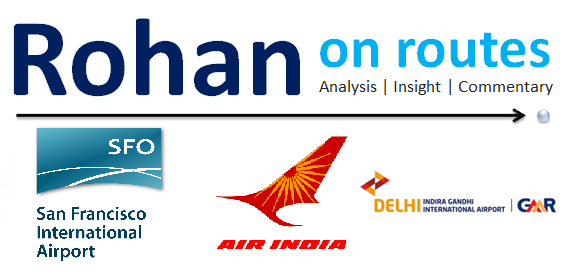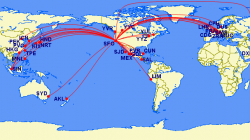
The first, second and third time was not the charm, but starting December 2, 2015, Air India will launch its first ever nonstop service from the U.S. West Coast to India when it inaugurates a thrice-weekly service to San Francisco from its Delhi hub, operated on a 3-class Boeing 777-200LR.
Air India will be operating an early morning schedule arriving into and departing from San Francisco, with a 6AM arrival and 10 AM return to Delhi. It will arrive in Delhi the following afternoon on the inbound flight and leave at 2:45 AM from Delhi on the outbound to San Francisco.
AI173 DEL0245 – 0600SFO 77L 357
AI174 SFO1000 – 1535+1DEL 77L 357
The U.S. West Coast is not unfamiliar with Indian carriers
Air India announced on 28 September that it had officially opened reservations for its planned new service from Delhi – San Francisco, although it will not be the first Indian carrier to serve San Francisco, nor the U.S. West Coast. Air India previously operated a direct flight from Los Angeles to Mumbai via Frankfurt utilizing Boeing 747-400s from June 2004 through September 2008, alternating between 3 to 6 weekly services throughout the four year period.
Jet Airways also served San Francisco on its own metal from Mumbai via Shanghai briefly for several months in 2008 and 2009 before cancelling the route due to the impact of the Global Financial Crisis. Jet has since resumed services to San Francisco in a virtual manner through its partnership with Etihad Airways via Abu Dhabi. Jet Airways has dry-leased two 777-300ERs to Etihad, which are operated by Etihad crews and featuring the Etihad on-board product, to operate a nonstop service from San Francisco to Abu Dhabi, with onward connections to India, since November 2014.
As I previously wrote,
A dry lease agreement, often used by commercial air carriers during longer-term aircraft swaps, permits an airline to provides one or more aircraft to another airline without insurance, crew, ground staff, supporting equipment and MRO (maintenance, repair and outsourcing). In this scenario, the lessee (being Etihad) registers the two aircraft under its own Air Operators Certificate (AOC). Although the flights will bear the Jet Airways livery and paint scheme, the aircraft themselves are operated by Etihad flight crews, and feature Etihad’s 3-class cabin layout and hard product. In addition, the registration of the aircraft in the U.A.E., rather than India, circumvents the Category II restrictions that prevents Jet Airways from adding services to the U.S. based on failure to pass US FAA safety audits.
Read more: Etihad announces San Francisco using an atypical approach for a Gulf carrier, posted July 16, 2014
Additionally, now defunct Kingfisher Airlines had intended to launch nonstop services from San Francisco to Bangalore in 2008 utilizing an Airbus A340-500. The route never materialized and ultimately became a victim of Kingfishers’ demise in 2012 when its long-haul fleet was grounded and the carrier eventually folded.
As such, Air India’s venture to San Francisco will be the fourth attempt to serve the U.S. West Coast from India, after three attempts and failures which preceded it (including one that never left the ground).
Air India joins Air Canada in venturing into routes that have been unviable in the past
Air India’s confidence in the viability of increased nonstop service between India and North America is reflective of similar optimism held by Air Canada, although some key differences exist. In essence, both Air Canada and Air India have hoped to replicate the success that United Airlines has had on its nonstop routes from Newark to Delhi and Mumbai since the mid-2000s. United, which inherited the two routes from Continental, remains one of the few carriers that has consistently been able to maintain year-round service between the U.S. and India without interruption. Although Air India has been operating nonstop routes from Chicago, New York JFK and Newark to India since 2010, the general understanding is that these three routes are highly loss-making for the carrier and are subsidized by the Government of India.
Similar to Toronto, the Bay Area is home to a large demographic of the U.S. Indian diaspora, while also home to a robust number of Fortune 500 companies that frequently send corporate travelers between the U.S. and India due to strong business ties in the technology and finance sectors. The challenge for Air India, however, will be tailoring its premium class products to the high-yielding business traffic in the Bay Area that is unfamiliar with its brand, or more candidly speaking, uninspired to invest in its brand due to poor perceptions. Air India is not highly regarded, by both ethnic and corporate traffic alike, for its on-time performance reputation, helpfulness of ground handling staff and travel agents and overall on-board customer experience can be hit or miss.
Air India’s hubs have also been poorly designed in the past to capture connecting traffic over Delhi to smaller Indian markets, a void that has been filled by the emergence of Emirates, Etihad and Qatar in enabling North American passengers to travel on 1-stop itineraries over their hubs in Dubai, Abu Dhabi and Doha, respectively to cities all over the continent.
Further, while Air India is a member of Star Alliance, and San Francisco is a major hub for Star Alliance member United Airlines, the two carriers have an extremely limited cooperation agreement in place. Neither carrier currently codeshares with the other on any of their U.S. to India routes served on Air India or United, nor on United and Air India domestic and regional flights from Chicago, Newark, San Francisco on United or Delhi and Mumbai on Air India. United frequent fliers based out of SFO may also encounter challenges with reciprocal frequent flier benefits awarded to United elites traveling on Air India metal, as the earning and redemption rates are generally unfavorable and the decreased ROI value may deter higher-paying elites to fly on United’s other Star Alliance partners, such as Lufthansa, SWISS and All Nippon Airways, to reach the Indian markets from SFO.
Air India will also be utilizing a low-density 777-200LR for its San Francisco – Delhi flight which will be costly to operate. Air India has two 77Ls in service and one which is parked, and all three were delivered to the carrier in 2009, according to CAPA Fleet Database. The current configuration of AI’s 77Ls offers 238 seats, with 8 in First, 35 in Business and 195 in Economy. The challenge with Air India’s decision to select a 77L on this route is that with limited fleet flexibility, the operation runs under the assumption of an extremely lean fleet rotation, which can pose risks should a maintenance issue occur. Should Air India eventually want to increase frequencies, this may also require some additional creativity since it only has two 777-200LRs in service.
Furthermore, the 77L has grown in unpopularity among global airlines as it is not particularly fuel efficient. Air India may be taking advantage of low fuel prices to build brand awareness in San Francisco before ultimately replacing the 77L with a more cost-effective aircraft.
Air Canada is utilizing a much more measured approach to its India launch
Conversely, Air Canada’s much more measured approach to the Indian market entailed a route announcement in December of 2014 to build market awareness along with the strategic use of its newest, most fuel-efficient aircraft, the 787. Air Canada will deploy the 787-900 thrice weekly from Toronto to Delhi, which offers 297 seats spread across Business (29 seats), Premium Economy (21 seats) and Economy (247 seats), and a single weekly 787-800 variant which features 250 seats with 19 Business seats, 21 Premium Economy seats and 210 Economy class seats.
This is a widely different approach to Air India’s utilization of a First Class cabin, which is an obsolete product on Air India that has been known to carry mileage passengers and non-revenue travelers rather than full revenue paying-customers. This, against the backdrop of an evolving global industry trend for airlines to phase out the usage of First Class as demand has waned, casts further doubt on whether Air India employs strategic capacity discipline on its ultra long-haul routes.
Read: Air Canada hedges on 787 to viably serve challenging Canada – India market
Air Canada has also been proactive in formulating deep codeshare ties with Air India in addition to their joint participation in Star Alliance. Currently, Air Canada places its code on Air India-operated flights from Delhi to Amritsar, Bangalore, Chennai, Hyderabad and Kolkata, as well as from Mumbai to Bangalore, Chennai, Hyderabad and Kolkata. Air India places its code on several Air Canada-operated flights from London Heathrow to Toronto, Vancouver, Calgary, Edmonton, Halifax and St. John’s, as well as Paris to Toronto and Montreal and Vancouver to Hong Kong and Shanghai.
This contrasts starkly to the relationship between Air India and United, which is cordial at best. However, Air Canada needed a deeper cooperation with local Indian carriers given the higher concentration of price-sensitive VFR traffic that travel between Canada and India as opposed to the U.S. and India. United, on the other hand, has always been more protective of its joint venture agreements with Lufthansa and ANA to flow the U.S. – India market over Newark, Frankfurt, Munich, Zurich, Vienna and Tokyo, although limitations exist given that the vast majority of these hubs do not reach smaller markets in India.
Air India will not be insulated from the impact of the Gulf Coast carriers
Presently, San Francisco is a highly fragmented market with regards to 6th freedom air carriers offering 1-stop connections to India. Not only will Air India have to contend with an entrenched list of carriers from Asia, Europe and the U.S. (including United and now Air Canada over Newark and Toronto, respectively) but also the presence of the Gulf Coast carriers, including Emirates, Etihad and Turkish Airlines.
Emirates has been serving San Francisco utilizing an Airbus A380-800 for the better part of the year, with a departure and arrival bank from and to Dubai connecting with all of the major Indian markets. Etihad’s 777-300ER service has been utilizing the same departure and arrival times into SFO from Abu Dhabi since its inception, and also provides a 3-class product (as does Emirates) on its San Francisco route. The route was timed specifically to connect to major departure and arrival banks out of Abu Dhabi to the subcontinent.
Although there will be time-savings for passengers traveling solely between San Francisco and Delhi, the advantage of a nonstop will be muted for passengers traveling onward to destinations such as Mumbai, Hyderabad and Bangalore given that there will not be significant time savings achieved by the nonstop. Further, Abu Dhabi has a U.S. PreBorder clearance facility to process passengers in-bound to the United States, which will be a competitive advantage over Air India.
San Francisco will present a challenge for Air India without further actions
Air India has likely concluded that it is a safe time to open its San Francisco station given its restoration to Category I restrictions by the ICAO, its membership with Star Alliance, albeit limited in terms of benefits passed onto customers, the business and personal ties between the Bay Area and India and starting flights in the peak season of travel to India.
However, Air India’s current strategy to open up a fourth station in North America is unsustainable at its current level. Though customers will benefit from a new entrant offering competitive fares to India before peak travel season arrives, December round-trip fares between SFO and DEL are already experiencing major pricing gouges by 6th freedom operators such as China Southern and Turkish Airlines in Economy class. Premium cabin fares are also available in the sub-$4,000 range on Star Alliance carriers during Christmas, according to ITA Software by Google.
Furthermore, long-term, Air India will be entering into a saturated market and will have a hard time luring away corporate contracts and businesses to fill its flights with an unreliable product. The carrier needs to utilize a more reliable aircraft with better fuel efficiency when irregular operations occur or when fuel prices escalate. Finally, Air India will need to deepen its ties with United Airlines in order to maximize the value of its frequent flier program to United elites.
Without all of these things in place, Air India will encounter significant roadblocks in Northern California.


